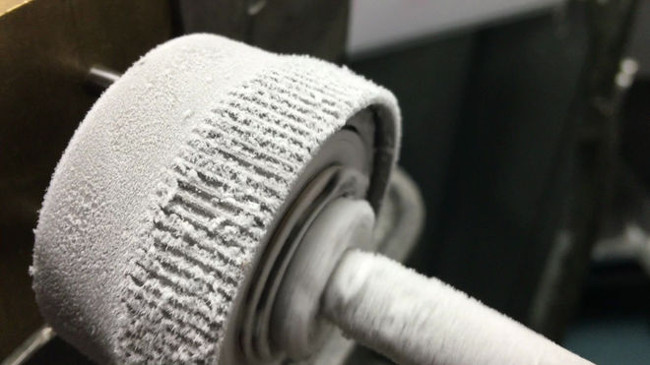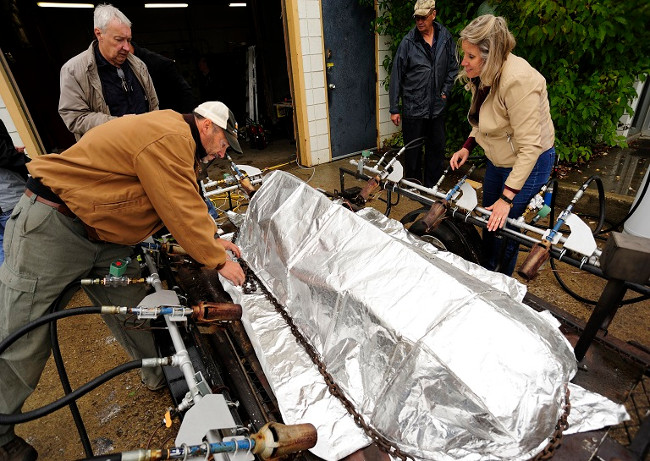Should metal gears be used in space missions?
" A material called metallic glass, created by liquefaction, then quickly cooled metal, can be the ideal material to make interlocking robot gears " , according to new research.
The two new studies focus on using large quantities of metallic glass (BMG ) as a material in making gears for space missions. Metal glass is called BMG when used to produce products larger than 1mm (0.04 inches).
 Large quantities of metal glass are formed to melt and swim after ccos quickly cool metal, not too brittle when the weather is extremely cold.Two new studies examine the effectiveness and cost of making gears for space spacecraft from Large quantities of metal glass.Photo source: NASA / JPL-Caltech
Large quantities of metal glass are formed to melt and swim after ccos quickly cool metal, not too brittle when the weather is extremely cold.Two new studies examine the effectiveness and cost of making gears for space spacecraft from Large quantities of metal glass.Photo source: NASA / JPL-Caltech
To make large quantities of BMG metal glass, engineers must first melt the metal. Solid metals have a good crystal atomic structure. But when the metal melts, the atoms lose that structure and become random arrangements, according to a statement from NASA. If the metal slowly cools, the atoms will return to the original crystal arrangement. Conversely, if the solid metal quickly cools down - about 1000 degrees Celsius ( 1,800 degrees F ) in a second - then the "disorganized" structure shape remains the same.
Cool metals are also called amorphous metals and " by being cooled too quickly, the technical material is glass. It can be easily circulated and blown into hot molds. up, like glass window glass , NASA scientists explained in the results report.
Metal glass was first developed at the California Institute of Technology in the 1960s, and " used to produce everything from mobile phones to golf clubs ", NASA said in the announcement. To find out how large quantities of BMG metal glass can be good materials for gears for space spacecraft, Douglas Hofmann, a technology engineer at NASA's Jet Propulsion Laboratory ( NASA's Jet Propulsion Laboratory ) and also the main author of two studies, made gears from a large number of BMG metal glassware, and tested them at extremely low temperatures. One of two new studies, published in Advanced Engineering Materials, suggests that gears prove " strong torque " and smooth operation without lubricants at temperatures up to minus 200 degrees Celsius ( min. 328 degree F ).
 An example of a zero-speed gearbox, known as a harmonic drive - is one of the most expensive gears used in high-precision robots.When the gears rotate, the flexible ring inside it tightens, becoming an oval shape.Photo source: NASA / JPL-Caltech
An example of a zero-speed gearbox, known as a harmonic drive - is one of the most expensive gears used in high-precision robots.When the gears rotate, the flexible ring inside it tightens, becoming an oval shape.Photo source: NASA / JPL-Caltech
The performance of gears at extremely low temperatures is important for two reasons. First, some materials ( including some metals ) become brittle at cold temperatures, but that doesn't happen with metal glass. That means less risk occurs when a gear breaks during operation, according to the announcement.
The second benefit is energy consumption. " The ability of icy satellites to operate ultra-low-temperature gears, such as Jupiter's satellite Europa, is a potential change for scientists, " said R. Peter Dillon, a public engineer. technology and program management in JPL's material and technical development team. " Energy is no longer drained by scientific tools for heating lubrication gearboxes, conserving battery power ."

Other benefits of BMG gears are low cost and easy to produce. Parts made from large quantities of BMG metal glass are molded by injection molding technology, according to NASA's statement, which means the material is liquefied and pumped into the mold. This technique is also used to produce plastic parts.
Two studies conducted by Hofmann and colleagues show that bulk gears of BMG metal glass are more cost effective than deformed wave gears, which are " common in expensive robots. ", according to the announcement. In particular, these gears consist of a flexible metal ring, which is "difficult to mass produce and popular in expensive robots. Therefore, BMG gears can produce less", the NASA officials said in the report.
" Shear wave mass production using BMGs has a big impact on the robot consumer market, " Hofmann said. " This is especially true for humanoid robots, using gears in joints can be very expensive to prevent shaky hands. Low-temperature performance for JPLs and robots seems to be a benefit to increase happiness ".
You should read it
- Reveal the best place to find life on Mars
- NASA has to postpone the historic flight into space because of bad weather
- The reason the plane cannot fly into space
- 11 interesting facts about ISS International Space Station not everyone knows
- The 7 largest objects people ever launched into space
- SPACE function in SQL Server
- How clean are astronauts keeping the space station?
- What is color space?
May be interested
- Unexpected discoveries of the full moon
 this phenomenon is always associated with mystical stories that make scientists headaches.
this phenomenon is always associated with mystical stories that make scientists headaches. - It turns out this is how the galaxy Milky Way formed 13.5 billion years ago
 a new technology map that simulates the way the milky way galaxy formed in the universe over tens of billions of years ago is making the global astronomers flutter.
a new technology map that simulates the way the milky way galaxy formed in the universe over tens of billions of years ago is making the global astronomers flutter. - The mysterious flaw developing in supernova Tycho is astonishing to the scientific world
 when conducting supernova observations tycho at the purple mountain observatory (pmo) in nanjing, china, a group of chinese scientists discovered a mysterious phenomenon on the surface of this supernova that made astounding astronomers.
when conducting supernova observations tycho at the purple mountain observatory (pmo) in nanjing, china, a group of chinese scientists discovered a mysterious phenomenon on the surface of this supernova that made astounding astronomers. - A 30-ton meteorite was discovered hitting Earth 4,000 years ago
 scientists have discovered a giant meteorite weighing 30 tons has crashed into earth in a meteor shower 4,000 years ago in argentina. this is the second largest meteorite ever found in history.
scientists have discovered a giant meteorite weighing 30 tons has crashed into earth in a meteor shower 4,000 years ago in argentina. this is the second largest meteorite ever found in history. - Interesting facts about Mars may be unknown to you
 mars - the red planet contains many mysteries inside, here are interesting facts that will surely surprise you.
mars - the red planet contains many mysteries inside, here are interesting facts that will surely surprise you. - Did you answer the question: How many stars in the sky?
 perhaps this is one of the most difficult questions to answer because there are so many stars in the sky that we cannot count. so, with the help of modern technology, will astronomers count and give the correct answer? let's find out.
perhaps this is one of the most difficult questions to answer because there are so many stars in the sky that we cannot count. so, with the help of modern technology, will astronomers count and give the correct answer? let's find out.






 How to Draw Gears in Inkscape
How to Draw Gears in Inkscape Gears Tactics: A tactical but action-packed genre
Gears Tactics: A tactical but action-packed genre How to Shift Gears on a Motorcycle
How to Shift Gears on a Motorcycle Successfully formulated, programmable, liquid metal fabrication that can conduct electricity
Successfully formulated, programmable, liquid metal fabrication that can conduct electricity Exotic metal knows 'transformations' back to the original shape no matter how deformed
Exotic metal knows 'transformations' back to the original shape no matter how deformed